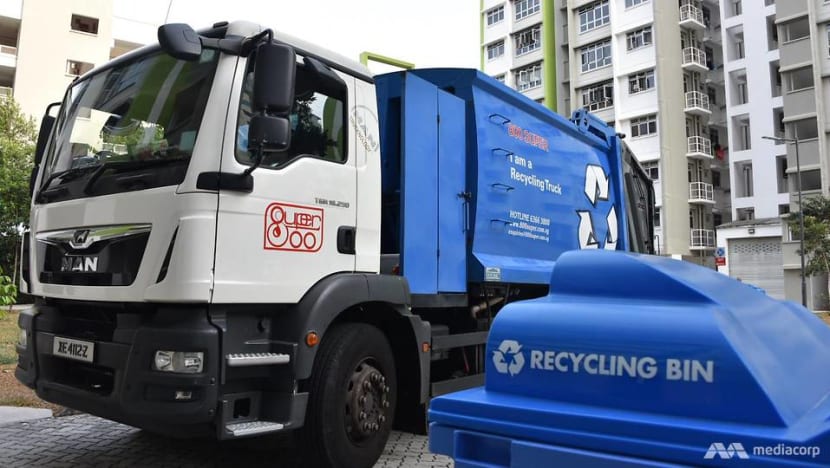Contamination of recyclables, incorrect recycling among possible factors for Singapore’s low domestic recycling rate: Experts

800 Super recycling truck pictured next to a blue recycling bin. (Photo: Darius Boey)
SINGAPORE: A number of factors such as the contamination of recyclables and incorrect recycling could have possibly contributed to Singapore’s low recycling rate among households, experts told CNA.
This follows statistics released by the National Environment Agency (NEA) on Wednesday (Apr 15) which showed that despite generating less waste, Singapore’s overall recycling rate fell in 2019.
Of the 7.23 million tonnes of waste produced last year, about 4.25 million tonnes, or about 59 per cent, was recycled – a dip from the recycling rate of 61 per cent in 2018.
In particular, Singapore’s domestic - from households - recycling rate fell 5 per cent from 22 per cent in 2018 to 17 per cent in 2019.
READ: Singapore generated less waste in 2019, but recycling rate also fell: NEA
CONTAMINATION A MAJOR PROBLEM
Ms Pek Hai Lin, who is the manager of non-governmental organisation Zero Waste SG, told CNA that contamination "seems to still be a huge problem", preventing items from being recycled.
Singaporeans may also be recycling incorrectly, throwing items which are not recyclable, into the blue bins, she added. This “decreases the efficiency of the waste management process”.
“They might engage in ‘wishful’ recycling, where they hope an item can be recycled or repurposed in some ways and thus place them in the blue recycling bin, which in turn causes inefficiency in the waste management process,” she said.
“For instance, mattresses and pillows cannot be recycled, and they are bulky, taking up precious space in recycling trucks, which will head to the sorting facility before heading to the incineration plant.”
Noting that a decrease in recycling rate does not mean that people are recycling less, Ms Pek added: “In fact, despite contamination rate still being high, people seem more aware and interested in better waste management habits, which is heartening.”
Many also “do not have the inclination” to properly separate and properly dispose of recyclables, added Associate Professor Tong Yen Wah from the Department of Chemical and Biomolecular Engineering at the National University of Singapore, and more education is needed in this area.
“We are too used to the conveniences of throwing everything into one bin or chute, and do not bother to recycle properly," he said.
"Having good infrastructure such as more recycling locations that are closer or easier to access, and having incentives such as the reverse vending machines can help too, because there is currently a lack of easily accessible ways to recycle."
Waste collectors he spoke to recently also said there has been an increase in the contamination rate in the recyclables they collect, and have had to divert more recyclables to the incineration plants, said Assoc Prof Tong.
READ: Singapore to reduce Semakau waste by 30% under first Zero Waste Master Plan
READ: 60% of Singaporean households recycle regularly, but many not doing it right: Surveys
Ms Pek said the rubbish chute discourages recycling as there is a “lack of accountability” for residents who may dispose of waste irresponsibly, which can contribute to contamination as well.
“Explicit education is needed for Singaporeans to know what to recycle, as there are still quite some misconceptions on the ground which we try to address whenever possible,” she added.
EXPORT OF PLASTIC AND PAPER
A drop in demand for recyclable materials overseas could also have also been a factor in the decrease, said experts.
This would include countries such as China banning imports of recyclable materials as well as restrictions on imports from countries such as Malaysia and Thailand, creating more supply than buyers, said Ms Pek.
“This seems to have resulted in a drop in prices of some recyclable materials, such as paper and plastic, deeming it much less profitable to go through much effort to collect and sell the materials,” she added.
According to NEA, the drop in the overall recycling rate is “largely attributable” to the drop in the recycling rate of paper.
“The market for recycled paper was affected by shrinking export markets and reduced demand for printing paper from increasing digitalisation,” said NEA on their website.
“Given that 34 per cent of Singapore’s recyclables are exported, the status of the external market and policy of other countries towards recyclables would have a significant impact on our recycling rate."
READ: ‘Not enough for coffee’: Karung guni men, cardboard collectors hit hard as scrap prices and volume fall
Ms Melissa Tan, chairman of the Waste Management and Recycling Association of Singapore, said knowing that paper and plastic waste will eventually be incinerated could discourage people from recycling.
“People can place their used paper in the blue bins, but if the paper cannot be exported, they would have to be disposed of," she said.
"Some people may thus be less inclined to recycle paper or plastics because they know that there is no market for them overseas and they would be incinerated.”
Adding that the solution might be for paper and plastic recycling plants to be built in Singapore, she added: “This will then encourage more people to recycle them because they know their used paper and plastic bottles will actually be recycled and not simply incinerated.”
Some Singaporeans also might lack faith in the country’s recycling system, and may hence decide not to recycle, noted Plastic-Lite Singapore founder Aarti Giri.
“When someone goes to drop off their recyclables in the blue bin, and spot regular trash in the same bin, their belief in the system, rightfully so, may reduce,” she said.
“They may get dejected seeing this and stop recycling altogether, thinking everything is going to get incinerated anyway.”
But experts remained generally positive that Singapore will be able to reach its target of a domestic recycling rate of 30 per cent by 2030.
Under the Sustainable Singapore Blueprint, targets include increasing the nation’s overall recycling rate to 70 per cent, non-domestic recycling rate to 81 per cent and domestic recycling rate to 30 per cent in ten years.
“If the general market situation does not change and we continue to rely on exporting our recyclables for processing, we might not be able to achieve the target,” said Ms Pek.
“However, with schemes such as extended producer responsibility for e-waste and packaging kicking in, in the next few years, it can still be possible to reach the target if Singapore is able to own a certain percentage of recyclables processing, which we should.”
Added Assoc Prof Tong: “I think we can definitely achieve 30 per cent domestic recycling by 2030 as that is not a high (target). Other countries like Japan, South Korea, Germany have a much higher recycling rate, so this target is definitely achievable if we do our best.”














